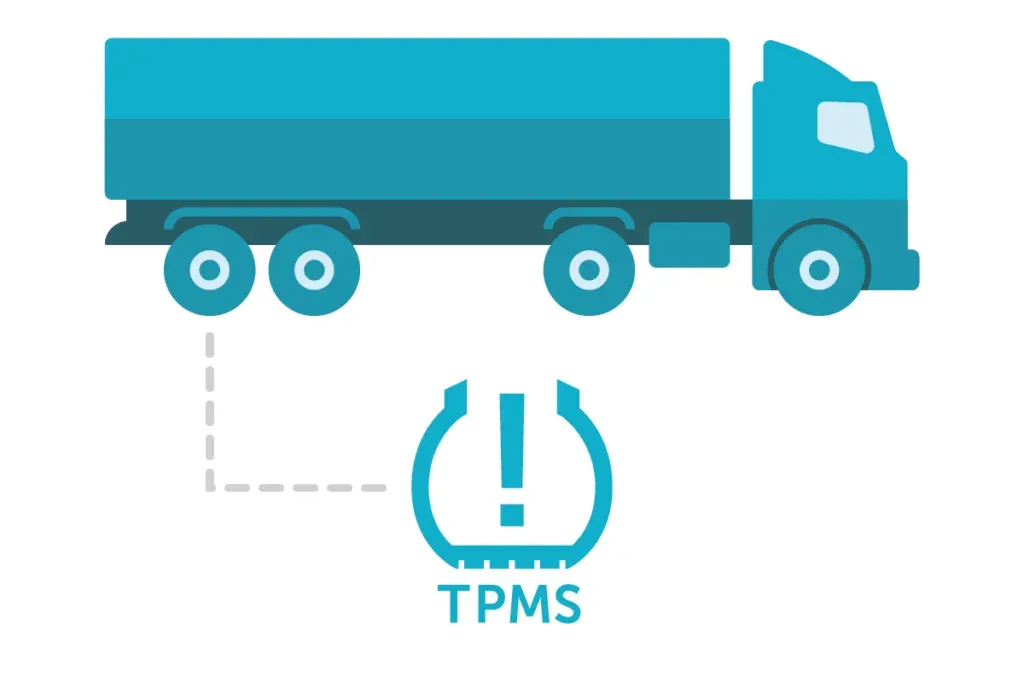Maintaining a fleet of vehicles is a significant investment for a business. Keeping the vehicles in good condition and ensuring that they are safe to operate is essential in order to avoid accidents and downtimes caused by breakdowns. One crucial aspect of vehicle maintenance is monitoring tyre pressure. Tyre sensors are innovative tech features that make it easy to keep track of tyre pressure in real time, ensuring that vehicles are always safe to operate.

What Are Tyre Sensors?
Tyre sensors are small electronic devices that are installed in tyres. They are designed to provide real-time data about the tyre pressure and temperature of the tyres, which is then transmitted wirelessly to the vehicle’s onboard computer. The information is displayed on the dashboard, allowing the driver to monitor tyre pressure at a glance.
Remote Tyre Pressure Monitoring System
Prevent vehicle breakdowns by keeping perfect control over the pressure of your tyres. Prevent flats and save on fuel.
Increase the lifetime of your tyres

How Do Tyre Pressure Sensors Work?
Tyre pressure sensors work by using a small pressure sensor to measure the air pressure inside the tyres. The signal from the sensor is transmitted wirelessly to the vehicle’s onboard computer, which processes the information and can display it on the dashboard if necessary.
Tyre pressure sensors are typically powered by a small battery that lasts for several years. The sensors are designed to be low-power. As a result, they do not drain the battery quickly. When the battery runs low, the sensor will send an alert to the onboard computer, indicating that it needs to be replaced. Though less accurate, it is also possible to monitor tyre pressure by monitoring changes in the wheel speed. This is because a lower tyre pressure makes it more difficult for the wheel to rotate.
Tyre valves with sensors are a type of tyre sensor that is installed directly into the tyre valve stem. They are designed to replace the existing valve stem and provide real-time tyre pressure and temperature data. Tyre valves with sensors are easy to install and can be used on most vehicles.
Where Are Tyre Pressure Sensors Located?
Tyre pressure sensors are located inside the tyre as part of the valve stem. The sensors are designed to be light in weight and do not affect the balance of the wheel. Tyre pressure sensors are typically located on each wheel, providing real-time data about the pressure and temperature of each tyre. This allows the driver to monitor tyre pressure at a glance and take action if any tyre is underinflated or overheating. Typically, pressure readings are only presented to the reader while driving if pressure drops by an amount that should be cause for concern.
The Benefits of Using Tyre Sensors
Using tyre sensors provides several benefits for businesses that operate a fleet of vehicles. These benefits include:
- Improved Safety: One of the most significant benefits of using tyre sensors is improved safety. Tyres that are underinflated or overheating can cause accidents, especially at high speeds. Tyre sensors provide real-time data about tyre pressure, allowing drivers to take action if any tyre is underinflated or overheating rather than finding out when an issue occurs.
- Reduced Downtime: Tyres that are underinflated or overheating are more prone to failure, resulting in costly downtime for the vehicle. By using tyre sensors, businesses can remotely monitor tyre pressure in real time, reducing the risk of downtime.
- Increased Fuel Efficiency: Soft tyres require more energy to move, resulting in increased fuel consumption. By using tyre sensors to maintain proper tyre pressure, businesses can increase fuel efficiency and save money on fuel.
- Extended Tyre Life: Underinflated tyres are more prone to damage as well as regular wear and tear, reducing their lifespan. By using tyre sensors to maintain proper tyre pressure, businesses can extend the life of their tyres. This reduces the need for frequent replacements and helps save money in the long run.
- Easy Maintenance: Tyre sensors make it easy to maintain tyre pressure and reduce the need for manual checks or adjustments. This saves time and labour costs, allowing businesses to focus on other aspects of vehicle maintenance.
- Compliance with the Law: Driving with unsafe tyres is against the law and carries penalties in the form of fines and penalty points. Pressure sensors make it easier to ensure this never happens.
Conclusion
Tyre sensors make it easy to monitor tyre pressure in real time. They are designed to provide accurate data about tyre pressure and temperature, allowing drivers to take action if any tyre is underinflated or overheating. Tyre sensors are easy to install and can be used on most vehicles, making them a cost-effective solution for businesses that operate vehicle fleets.
By using tyre sensors, businesses can improve safety, reduce downtime, increase fuel efficiency, extend tyre life, and ensure compliance with road safety laws. Tyre sensors make it easier to maintain proper tyre pressure by reducing the need for manual checks and adjustments. This saves time and labour costs, so businesses can focus on other aspects of vehicle maintenance.
Sources:
- https://www.kwik-fit.com/
- https://www.goodyear.eu/en_gb/consumer/learn/what-is-tpms.html
- https://www.arnoldclark.com/newsroom/891-car-tyres-and-the-law-what-are-the-facts
Disclaimer
This content is provided for informational purposes only and is not meant to be an endorsement or representation by FleetGO.com or any other party. This information may contain inaccuracies or typographical errors, despite our efforts to ensure accuracy. FleetGO.com accepts no responsibility or liability for any errors or omissions, and is not responsible for the contents of any linked website or any link contained in a linked website. Please refer to our full disclaimer for more details.


